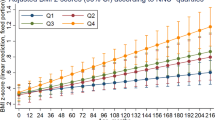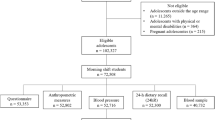Abstract
Objective:
The primary aim was to assess, the association of the quantity and quality of dietary fat intake from 6 to 12 months of age and serum lipids at 12 months.
Subjects/Methods:
Three hundred healthy term Swedish infants were recruited in a longitudinal prospective study at the age of 6 months; 276 remained in the study at 12 months. Food records and anthropometric data were collected monthly from 6 to 12 months; serum lipids were analysed at 6 and 12 months.
Results:
Swedish infants had a total fat intake within the Nordic recommendations, but intake of polyunsaturated fatty acids (PUFA) was low (5.6 percent of total energy (E%)) and intake of saturated fatty acids (SAFA) was high (15.1 E%). Higher PUFA intake was associated with lower total serum cholesterol (TC, B=−0.13, P=0.003), lower low-density-lipoprotein cholesterol (LDL-C, B=−0.12, P=0.004) and apolipoprotein B (B=−0.03) (P=0.034) in girls but not in boys. When data from the present study were compared to data from similar studies in Finland and Iceland, it appears that the quality of the dietary fat has greater impact on serum lipid levels than the quantity of fat in the diet.
Conclusions:
Higher PUFA and lower SAFA intakes may reduce TC and LDL-C early in life, particularly in girls. Further, with respect to lowering serum lipid concentrations in early childhood it seems appropriate to set focus on fat quality rather than the quantity.
Sponsorships:
Swedish Research Council for Environment, Agricultural Sciences and Spatial Planning (Formas), Swedish Research Council, Medicine, Stiftelsen Oskar Foundation, Sven Jerring Foundation, Samariten Foundation, Stiftelsen Goljes minne and Semper AB.
This is a preview of subscription content, access via your institution
Access options
Subscribe to this journal
Receive 12 print issues and online access
$259.00 per year
only $21.58 per issue
Buy this article
- Purchase on Springer Link
- Instant access to full article PDF
Prices may be subject to local taxes which are calculated during checkout

Similar content being viewed by others
References
Aggett PJ, Haschke F, Heine W, Hernell O, Koletzko B, Lafeber H (1994). Committee report: childhood diet and prevention of coronary heart disease. ESPGAN Committee on Nutrition. European Society of Pediatric Gastroenterology and Nutrition. J Pediatr Gastroenterol Nutr 1, 261–269.
Åkeson Karlsland PM, Axelsson IEM, Räihä NCR (1999). Plasma lipids and apolipoproteins in breastfed and formula-fed Swedish infants. Acta Paediatr 88, 1–6.
Åkeson Karlsland PM, Axelsson IEM, Räihä NCR, Warm A, Minoli I, Moro G (2000). Fat intake and metabolism in Swedish and Italian infants. Acta Paediatr 89, 28–33.
Ballew C, Kuester S, Serdula M, Bowman B, Dietz W (2000). Nutrient intakes and dietary patterns of young children by dietary fat intakes. J Pediatr 136, 181–187.
Barker DJP (2003). Commentary: developmental origins of raised serum cholesterol. Int J Epidemiol 32, 876–877.
Bayley TM, Alasmi M, Thorkelson T, Jones PJH, Corcoran J, Krug-Wispe S et al. (2002). Longer term effects of early dietary cholesterol level on synthesis and circulating cholesterol concentrations in human infants. Metabolism 51, 25–33.
Berenson GS, Srinivasan SR, Niclac TA (1998). Atherosclerosis: a nutritional disease of childhood. Am J Cardiol 82, 22T–29T.
Bergström E, Hernell O, Persson LÅ, Vessby B (1995). Serum lipid values in adolescents are related to family history, infant feeding, and physical growth. Atherosclerosis 117, 1–13.
Blomquist HK, Bergström E (2007). Obesity in 4-year-old children more prevalent in girls and in municipalities with a low socioeconomic level. Acta Paediatr 96, 113–116.
Butte NF, Wong WW, Hopkinson JM, Heinz CJ, Mehta NR, Smith EO (2000). Energy requirements derived from total energy expenditure and energy deposition during the first 2 y of life. Am J Clin Nutr 72, 1558–1569.
Die Referenzwerte für die Nährstoffzufuhr (2000). Available from:http://www.dge.de;p 11.
Dietary Guidelines for Americans (2005). Available from:http://www.healthierus.gov/dietaryguidelines.
Dietary Guidelines for Children and Adolecents in Australia (2003). Incorporating the infant feeding guidelines for health workers. N H M R Council. Available from:http://www.nhmrc.gov.au/publications/synopses/dietsyn.htm.
Fernandes J (2002). Nutrition and health – recommendations of the health council of the Netherlands regarding energy, proteins, fats and carbohydrates. Ned Tijdschr Geneeskd 14, 2226–2229.
Fridewald WT, Levy RI, Fredrickson DS (1972). Estimation of the concentration of low-density lipoprotein cholesterol in plasma, without use of the preparative ultracentrifuge. Clin Chem 18, 499–502.
Johnson RK (2000). Can children follow a fat-modified diet and have adequate nutrient intakes essential for optimal growth and development? J Pediatr 136, 143–145.
Kleinman R (2000). Towards a ‘new beginning’: dietary fat restrictions in infancy? Acta Paediatr 89, 2–4.
Lachat C, Camp JV, De Henauw S, Matthys C, Larondelle Y, Remaut A-M et al. (2005). A concise overview of national nutrition action plans in the European union member states. Public Health Nutrition 8, 266–274.
Lagström H, Jokinen E, Seppanen R, Rönnema T, Viikari J, Valimaki I et al. (1997). Nutrient intakes by young children in a prospective randomized trial of a low-saturated fat, low-cholesterol diet. The STRIP Baby Project. Special Turku Coronary Risk Factor Intervention Project for Babies. Arch Pediatr Adolesc Med 151, 181–188.
Lapinleimu H, Viikari J, Jokinen E, Salo P, Routi T, Leino A et al. (1995). Prospective randomised trial in 1062 infants of diet low in saturated fat and cholesterol. Lancet 345, 471–476.
Lind T, Lönnerdal B, Persson LÅ, Stenlund H, Tennefors C, Hernell O (2003). Effects of weaning cereals with different phytate contents on hemoglobin, iron stores, and serum zinc: a randomized intervention in infants from 6 to 12 mo of age. Am J Clin Nutr 78, 168–175.
Michaelsen KF, Hernell O (1995). Restriction of fat in the diet of infants. Lancet 345, 1117.
Michaelsen KF, Weaver L, Branca F, Robertson A (2003). Feeding and Nutrition of Infants and Young Children. WHO regional publications, European Series no 87.
Nordic Councils of Ministers, Copenhagen (2004). Nordic Nutrition Recommendations 2004 4th edition, Copenhagen, Scanprint as, Århus.
Nordiska Ministerrådet Köpenhamn (1996). Nordiska Näringsrekommendationer 1996 Nord 1996: 28.
Owen CG, Whincup PH, Odoki K, Gilg JA, Cook DG (2002). Infant feeding and blood cholesterol: a study in adolescents and a systematic review. Pediatrics 110, 597–608.
Prentice A, Branca F, Desci T, Michaelsen KF, Fletcher RJ, Guesry P et al. (2004). Energy and nutrient dietary reference values for children in Europe: methodological approaches and current nutritional recommendations. Br J Nutr 92 (Suppl 2), S83–S146.
Samuelson G, Bratteby LE, Mohsen R, Vessby B (2001). Dietary fat intake in healthy adolescents: inverse relationships between the estimated intake of saturated fatty acids and serum cholesterol. Br J Nutr 85, 333–341.
Simell O, Niinikoski H, Rönnemaa T, Lapinleimu H, Routi T, Lagström H et al. (2000). Special Turku Coronary Risk Factor Intervention Project for Babies (STRIP). Am J Clin Nutr 72, 1316S–1331S.
Svahn JCE, Feldl F, Räihä NCR, Koletzko B, Axelsson IEM (2000). Fatty acid content of plasma lipid fractions, blood lipids, and apolipoproteins in children fed milk products containing different quantity and quality of fat. J Pediatr Gastroenterol Nutr 31, 152–161.
Svahn JCE, Feldl F, Räihä NCR, Koletzko B, Axelsson IEM (2002). Different quantities and quality of fat in milk products given to young children: effects on long chain polyunsaturated fatty acids and trans fatty acids in plasma. Acta Paediatr 91, 20–29.
Tennefors C, Coward WA, Hernell O, Wright A, Forsum E (2003). Total energy expenditure and physical activity level in healthy young Swedish children 9 or 14 months of age. Eur J Clin Nutr 57, 647–653.
The National board of Health and Welfare, Stockholm (1999). Breast-feeding, children born 1996 Available fromhttp://www.socialstyrelsen.se/Publicerat/2001/2414/2001-42-9.htm
Thorsdottir I, Gunnarsdottir I, Palsson GI (2003). Birth weight, growth and feeding in infancy: relation to serum lipid concentration in 12-month-old infants. European Clin Nutr 57, 1479–1485.
Truswell AS (1995). Cholesterol-lowering in infancy? Lancet 345, 468–469.
Acknowledgements
We are grateful to the participating children and their parents in the study and to research nurse Margareta Henriksson, Umeå, for help with collecting data. Catharina Tennefors, Semper AB, contributed in the planning of the study. We also thank Hans Stenlund, Public Health and Clinical Medicine, Epidemiology and Public Health Sciences, Umeå University, for invaluable statistical support.
Author information
Authors and Affiliations
Corresponding author
Rights and permissions
About this article
Cite this article
Öhlund, I., Hörnell, A., Lind, T. et al. Dietary fat in infancy should be more focused on quality than on quantity. Eur J Clin Nutr 62, 1058–1064 (2008). https://doi.org/10.1038/sj.ejcn.1602824
Received:
Revised:
Accepted:
Published:
Issue Date:
DOI: https://doi.org/10.1038/sj.ejcn.1602824
Keywords
This article is cited by
-
Study protocol: optimized complementary feeding study (OTIS): a randomized controlled trial of the impact of a protein-reduced complementary diet based on Nordic foods
BMC Public Health (2019)
-
Obesogenic dietary intake in families with 1-year-old infants at high and low obesity risk based on parental weight status: baseline data from a longitudinal intervention (Early STOPP)
European Journal of Nutrition (2016)
-
When and how to start prevention of atherosclerosis? Lessons from the Cardiovascular Risk in the Young Finns Study and the Special Turku Coronary Risk Factor Intervention Project
Pediatric Nephrology (2012)
-
Serum lipid and apolipoprotein levels in 4-year-old children are associated with parental levels and track over time
European Journal of Clinical Nutrition (2011)
-
Essential fats for future health. Proceedings of the 9th Unilever Nutrition Symposium, 26–27 May 2010
European Journal of Clinical Nutrition (2010)



